MISCELLANEOUS
and
UNIDENTIFIED
PHOTOGRAPHS
MISCELLANEOUS
GROUP PICTURES
Can you identify anybody?
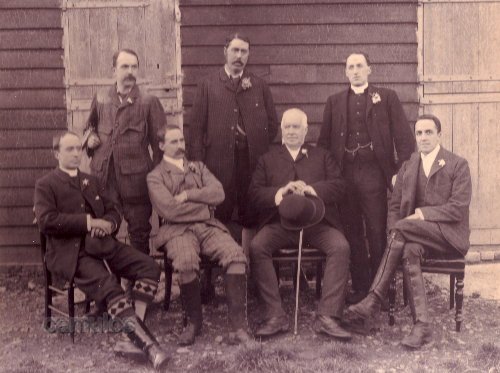
Above, a William Gill photograph, Colchester. They are all wearing buttonholes, there are shotguns and leg protectors. The gentleman top right is a cleric. A shooting party perhaps of the 1890 to 1910 period.
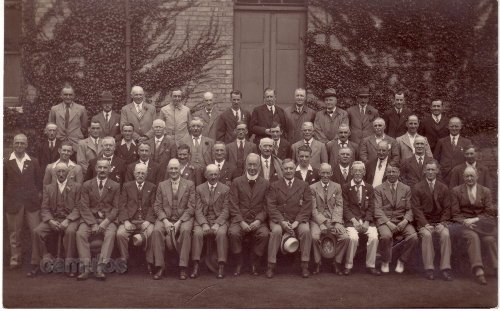 M425
M425
The above picture was taken by Bradley and Blowers of Mersea Road and probably dates from the 1950s. It looks like a vicar, centre front. Many are wearing buttonholes.
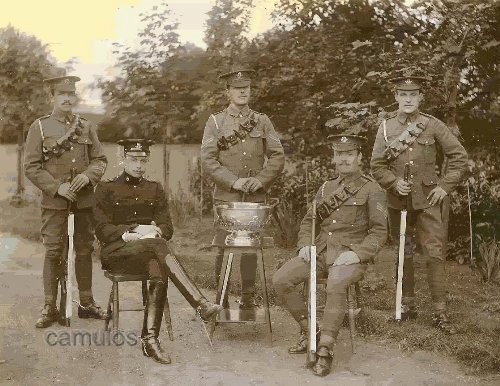
This above picture probably relates to General Henry Sinclair Horne, 1st Baron Horne Stirkoke and his family, General Horne's wife was the mother of Lieutenant Blacklock of the VIIth Hussars and his daughter Kate (Kitty ) Horne married her father's ADC Captain Hewson of the Royal Horse artillery. This is a polo team picture dated 1907. Clegg, Floyd, Lindsay Team.
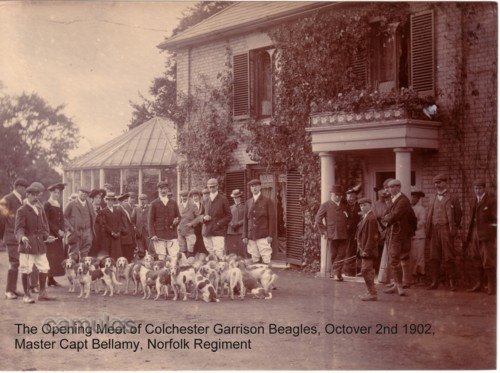
This photograph has been identified by David Lloyd, through the Unidentified Photos of the British Isles Group on Facebook, September 2024.
The location was Bovill'sHall, Ardleigh, Essex. The re-colouring was done by David Peter Coppin, through the same group.
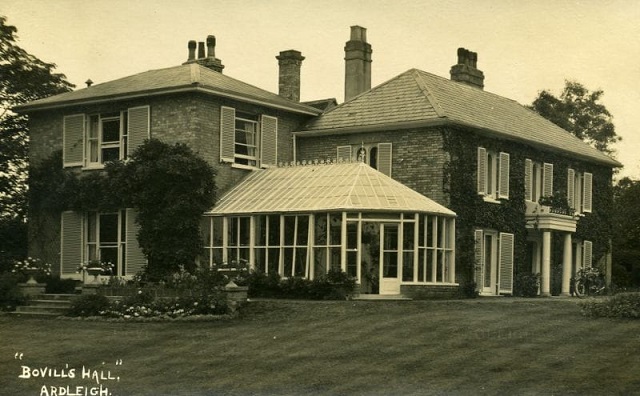
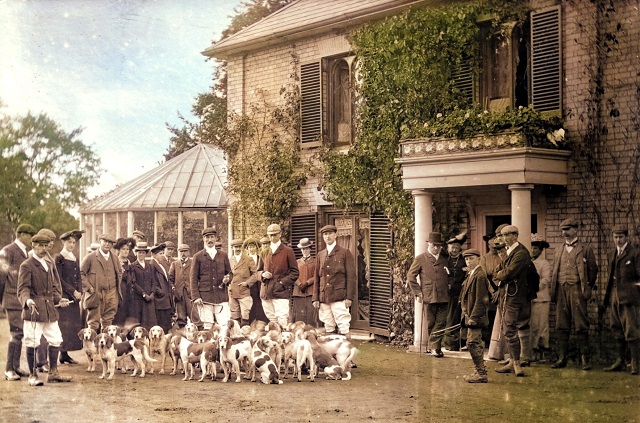
![]()
Here follows a collection of photographs that pre-date postcards, we think.
Unidentified photograph by
G A Oldham (Oldham and Angle) of 11 Queen Street
and 8 Mersea Road, Colchester Unidentified
photograph A photograph by Isaac Schofield,
Garrison and Camp Photographic Studio, Mersea Road,
Colchester on the back of this photograph by
Isaac Schofield is handwritten Ruben Hayes on right of
photo. Royal Lincolnshire
Regiment?
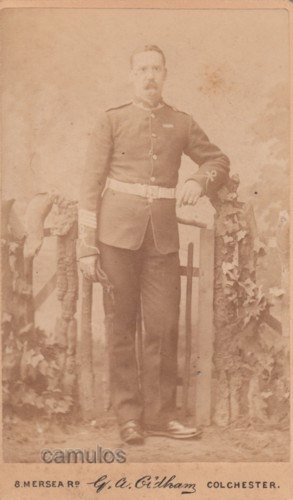
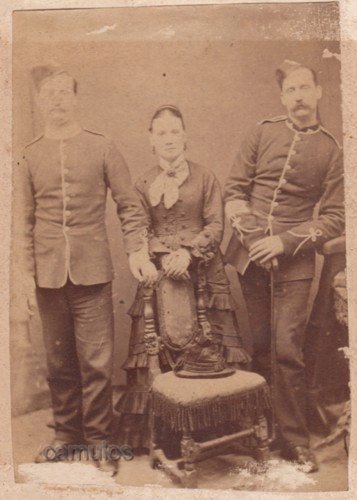
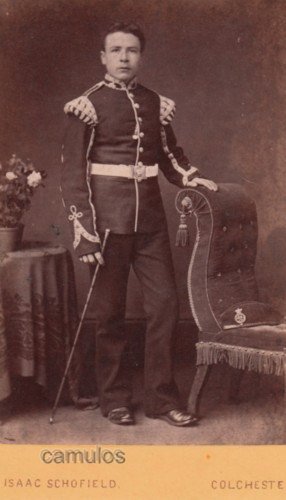
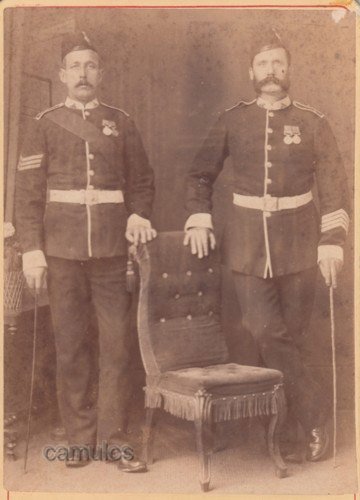
Yet to identify the building but written on the back is that this is the opening meet of the Colchester Garrison Beagles on October 10th 1902 with Master Captain Bellamy of the Norfolk Regiment. Is this the building on Flagstaff Road? Note the Norfolk jackets, the iron windows and plant troughs.
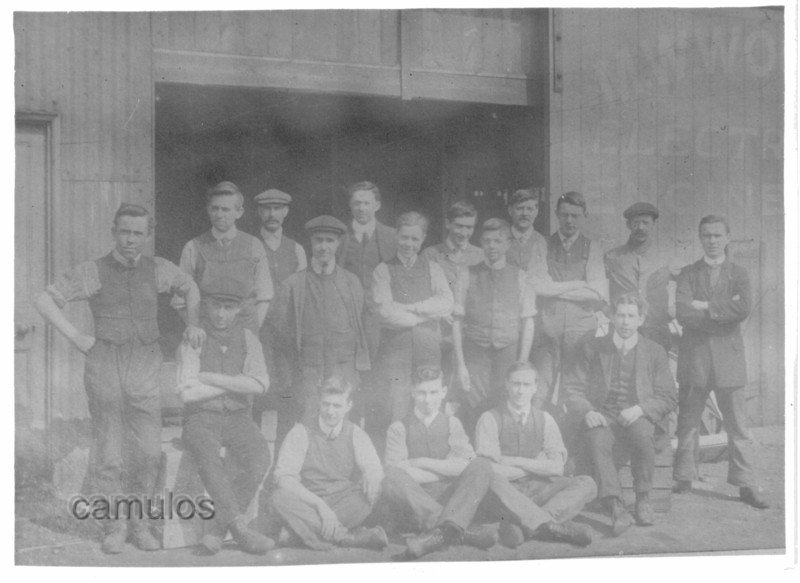
The above picture is believed to be that of the workforce of M Woods Electrical Engineers of Denmark Street, Colchester, the company that went on to become Woods of Colchester. The date would be around 1915. Do you recognise anybody. The following picture is a later one of Woods personnel.
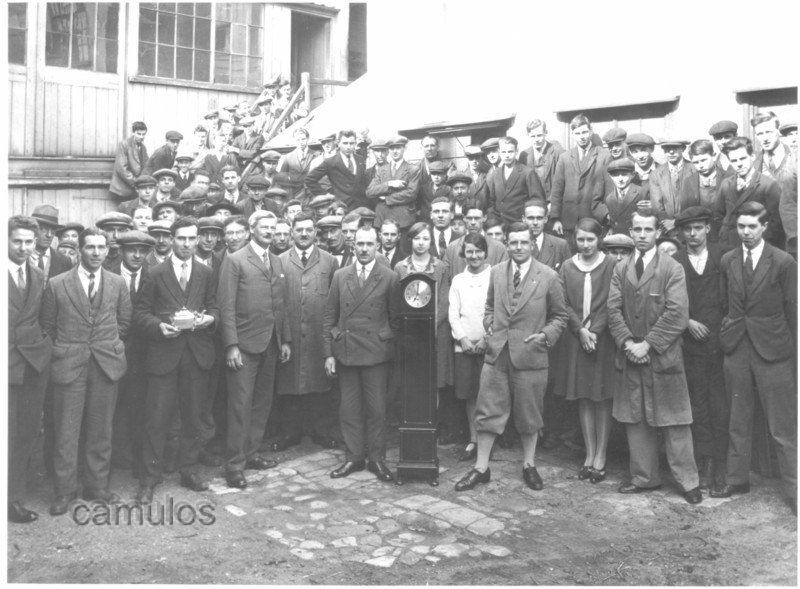
A presentation ceremony of a clock and a teapot, to workers at Woods of Colchester, Denmark Street, Colchester. Note the gentleman in 'plus fours' believed to be Maurice Woods. Dating from the 1930s? Do you recognise anybody? In April 2012, we heard from Annette Lewis, who has lived in the USA since 1973. She told us that,
'My grandfather, Frank Overton Parker, is the man on the left of the
grandmother clock. The clock was presented to him as a retirement
gift. I do not know the year but my grandfather was 48 years old. He
had been manager of Woods for some years. The two Woods sons came into
the business at that point and they did not see things as my grandfather
did, so he was persuaded to retire. I do not know what pension he was
given but he never did work again. I have a copy of this photograph. I
do not recognize the teapot so perhaps that was given to someone else.
The clock stood in the hall of my grandparents' house for as long as
they lived. I do not know the date of his death but believe it was in
the 1950's. My mother was Frank's middle daughter and she died
just short of age 101 this February'.
Annette Lewis
USA
![]()
High Street
The following are copies of photographs, mainly taken in 1957 but with the last two of earlier, but unknown, date.
If anybody can help with details of their origin, we would love to hear from them.
P001
The showroom in 1957. To the left of this picture is All Saints Church. To the right, St Nicholas Street.
P002
P003
P004
P006
P007
Note in the background the premises of Messrs Kent Blaxill across the road, that was later to be destroyed by fire.
P008
A view from the 1930s?
P009
The workers? Indeed they were. We received an email in April 2019, from Christine Gadsdon, that gave us a few details concerning one of the people in the picture.
My husband’s grandfather is man with the flat cap and pipe! Henry Percy Gadsdon - born 1876, died 1946. The 1911 census shows him living in Clacton on Sea, with his wife (who was born in Colchester), and described as a 'coach and motor body builder'. He was also an employer. Henry, at some time, owned Adams Garages. His son, David Gadsdon (my husband), had an aunt, Jo, who was a mechanic at Adams Garages, and David was lucky enough to have a rather large blue Austin pedal car, when a boy! David was born in 1947, just after his father, Percy, died. So, this photograph dates up to 1947 only. The garage was sold in 1957.
David’s eldest daughter, told us that the National Trust property, Arlington Court in Devon, has a coach display, and that part of that display is a large poster - Gadsdon Coachbuilders. See www.gracesguide.co.uk/Gadsdons.
This photograph is dated from 1878 and shows Mayor Thomas Moy and members of the town council of Colchester on the occasion of the opening of the Hythe Bridge 4th April 1878. He was a coal merchant who then lived at Hill House (now demolished) at the top of Hythe Hill. Paxmans Social Club (also demolished) later occupied the site. Note the mace bearer on the far left. The photographer was G G Crawford Barnes of 1 Priory terrace, Lexden Road. The picture is fading due to age.
This photograph came from Mr Don Goodman and shows a gathering of the National Union of Railwaymen, Colchester Branch. Mr Goodman tells us that his grandfather George Sealey is shown extreme left. The picture dated around 1920?
This is also from Mr Goodman who tells us it was taken in the Castle Park and relates to the railway union, as the previous picture. The postcard is unused and by The Southgate Studio, 3a Short Wyre Street, Colchester.
....also from Mr Goodman, two patriotic postcards
cards, both unused and both by Valentines.
UNKNOWN OR MYSTERY
A075-199
The suggestion written on the back of this unposted card is that it is Dilbridge/Pillbridge Hall or Ardleigh Court, Colchester. There is mesh over the downstairs windows and nurses and a red cross flag with the union flag flying from the flag pole. A rest home or convalescent home?
In 2025, Mr Martin Barnes advised that it was of Hart House, Burnham, Somerset.
THE HISTORY OF THE POSTCARD
1870 - Britain's first Postcards
Postcards have been used in Britain since they were first introduced by the Post Office in 1870. These cards were plain cards issued by the Post Office. They had a pre-printed stamp. The address was written on one side of the card and the message, often very brief, was written on the other side. There was no picture. Here is an example form 1890, in which one Edinburgh photographer is advising another of the date of a photographic society meeting:
1894 - Britain's first Picture Postcards
From 1 September 1894, the Post Office allowed postcards published by others to be posted. A halfpenny adhesive stamp was to be added to these cards before posting.
Several manufacturers produced cards. The first publisher to include pictures to the cards is believed to have been George Stewart of 92 George Street, Edinburgh.
1895 - Court Cards
From 1895 onwards, a size of 4.75 ins x 3.5 ins was adopted for postcards. These were known as Court Cards. The address was written on one side. The reverse bore a small picture leaving sufficient space to write a message.
1899 - Standard size of Postcard
From 1899 onwards, the standard size of 5.5ins ins x 3.5 ins, already in use in other countries, was accepted in Britain.
The address,, and nothing else, still had to be written on one side of the card. The other side being for the picture and message. In many cases the picture covered most of the card, leaving little room for the message.
1902 - Divided Backs
In 1902 the Post Office changed its rules and allowed:
- pictures to appear on the front of postcards
- message and address both to appear on the back.
The message was to be written on the left-hand side of the back and the address on the right-hand side of the back. Great Britain was the first country to allow this practice.
From around September 1902 onwards, postcard manufacturers began to issue cards with a line drawn down the middle of the back to show where the message and address should be written.
These cards soon replaced the earlier ones with 'undivided backs'.
1926 - Postcard Sizes
In 1926 the Post Office specified the sizes of postcard that were allowed:
- Min size: 4 ins x 2.75 ins.
- Max size 5.875 ins x 4.125 ins.
Postcards larger than the sizes above became more common later in 20th century, but they were not unknown early in the 20th century.
Postage Rates
in the UK
If the cards have been posted, the postmark date can establish the latest possible date that a postcard was produced - sometimes the date is not legible, so the stamps used can be a guide
Postage rates were sometimes printed on the backs of early UK postcards. These can help to determine the date of publication.
The normal postage rates for postcards are given below:
- ½d until 1918
There was no change in the 1/2d postage rate for inland postage for almost 50 years. (The overseas postage rate, at least in 1901, appears to have been 1d.)
- 1d from 3 June 1918
This doubling of the rate resulted in a decline in the number of postcards posted.
- 1½d from 13 January 1921
A further increase, imposed shortly after the 1918 doubling of the postage rate.
- 1d from 24 May 1922
(This reduction came about following protests over the previous two increases.)
However, in some cases many years, or even decades, passed from the time that a photograph for a card was taken or the time that a postcard was first published to the time of posting.
More pictures will be added in due course, if possible.
Return to
Main Page
![]()
Sdapeze
page created 220404
updated 021025
reconfigured 170921
Site Hosted
by